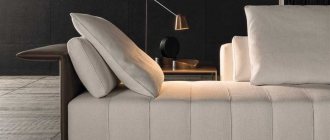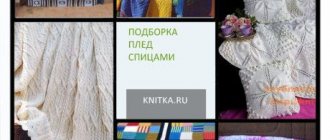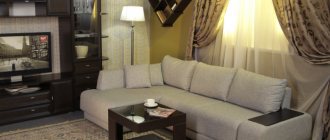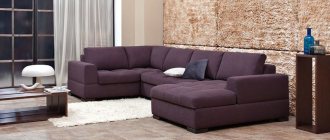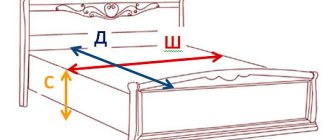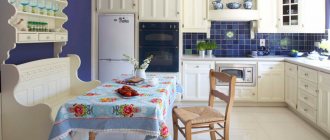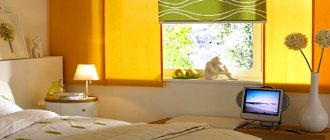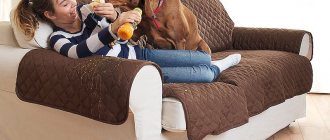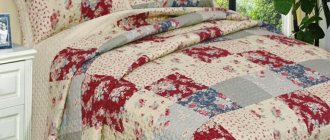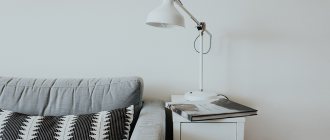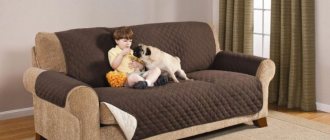There comes a time in the life of every housewife when she wants to radically change the interior design of her home. Moreover, it is advisable to do this without special financial and time costs, because repairing or purchasing new furnishings requires a lot of effort to implement such a large-scale idea. An elegant way out of the situation can be the “construction” of covers for upholstered furniture: they help not only to give it an aesthetic appearance, but also protect it from contamination, protect it from the encroachments of toothy-fanged household members, and give freshness and novelty to the room.
This operation will be less expensive if you try to do it yourself: if you have a sewing machine, you will only need to buy fabric. Then all that remains is to find out the details of the idea called “How to sew a cover for a corner sofa” and determine its features and requirements.
Getting to know the assortment
There are several options:
- Eurocovers . Fabrics that contain rubberized threads, which is why such capes can easily be transformed to fit the shape of furniture. Suitable for sofas of various configurations.
- Capes . There are several types:
- sets that include separate bedspreads for each element of the sofa;
- sets, each part of which is designed to cover a specific part of upholstered furniture;
- covers - coverings repeat the geometry of the sofas.
Covers and bedspreads have a rather significant advantage: they can easily fit into the washing machine, which is not possible with covers.
- Covers with elastic band . They stretch well, so they can be considered universal, suitable for sofas with various protrusions.
Tips for choosing
In order not to be disappointed in your purchase, before going to the store, decide on the following characteristics:
- Textile. Select based on the conditions of use. Study the most common materials and choose the option that suits the characteristics.
- Color. Decide on colors based on the overall style of the room. Remember that light-colored covers quickly become dirty and therefore require frequent washing. Give preference to a dense product that will retain its structure after many washes.
- Style. Directly depends on the type of structure. Find out if there are ready-made cases for your model.
- Dimensions. The cover must fit the dimensions of your sofa. Check which dimensions are required for the selected model.
The variety of types, styles, shapes and sizes of cases is completely confusing. Therefore, take advantage of some secrets of buying them:
A non-stretch regular cover requires knowledge of the exact dimensions of the furniture. Check with sellers for the required dimensions and double check them before purchasing. Custom cases are certainly quite expensive. However, this is a way to get a completely unique item that meets all practical and aesthetic requirements. Eurocase is the simplest and most convenient option. Easy to put on and take off, does not require special care
There is a wide range of this type of cover available for sale. When purchasing, pay attention to the weakest points of the product, namely: the quality of fittings and fastenings. This will help you immediately recognize a fake. Do not make a final purchasing decision without checking the quality of the seams, the integrity of the fabric, and the absence of defects. Remember, the more decorative elements, the more likely they are to fall off. In addition, a simple product is easier to care for. Read the instructions
There are covers made from fabrics that require special care. Sometimes covers are sold with ready-made accompanying products that match in style - bolsters, tablecloths, decorative pillows and napkins.
In addition, a simple product is easier to care for. Read the instructions. There are covers made from fabrics that require special care. Sometimes covers are sold with ready-made accompanying products that match in style - bolsters, tablecloths, decorative pillows and napkins.
Material is an important detail
After choosing a cover option, you should think carefully about the preferred fabric for it, because an unsuccessful choice can ruin all your efforts. The most popular:
- Flock , reminiscent of velvet, is an ideal choice for a bedroom or living room cover. This fabric may seem too soft, but this is a deceptive impression, since flock can be the optimal material if there is a need for protective covers. It also has other advantages: the absence of sunburn and the dislike of dust mites. But there may also be a fly in the ointment - a potential allergy of household members. Composition: cotton and synthetic fibers.
- Teflon flock (courtisan) . This fabric is coated with Teflon. Owners of pets who love to tear upholstery with their teeth and claws will be especially happy to purchase it. The material is also stain-resistant: grease, ink, food and drinks are easily removed.
- Velor . Just like flock, it is very similar to velvet. Only its price is more attractive. Due to the different directions of the pile, the fabric can be embossed, smooth or shaped. Covers made from these types of velor vary greatly in appearance. Among the advantages, it should be noted the absence of allergic properties and the ease of removing stains; among the disadvantages, it is fragility.
- Cotton . Eco-friendly material from which covers are made in very bright colors. But the fabric may shrink after washing, and its service life is also limited. Best used for children's bedrooms.
- Microfiber . A popular material among manufacturers of European covers. The fabric to which Teflon is added is especially durable. Without exaggeration, such microfiber can be called “eternal.”
- Chenille. Very soft, cozy and lightweight fabric. She owes the last quality to acrylic. Such a cover will look especially impressive on new furniture. On the old one, all the areas “occupied” by residents will be visible. It is not recommended to purchase glue-based chenille: it is both harmful and not strong enough.
- Jacquard . Extremely dense fabric, which is very difficult to deform and tear. Jacquard consists of cotton, polyester and elastane. These covers are recommended for pet lovers.
- Eco leather . It will be indispensable in a house where there are representatives of the younger generation, since their art will not cause irreparable damage to this cover and can be easily wiped off. But eco-leather is incompatible with animals.
- Upholstery nubuck . Fabric that can give respectability. The price matches the requests. But nubuck differs from other upholstery fabrics in its higher requirements: it needs to be vacuumed every day, and you will have to buy a special product to remove stains from the cover.
Purpose
When discussing the purpose of covers for upholstered furniture, it is appropriate to recall the expression that a problem is easier to prevent than to solve. Sofas and armchairs are an important and expensive part of home comfort. Their main disadvantage is the rapid wear of upholstery fabric and vulnerability to persistent marks from food, drinks, animal hair and cat claws.
After a home renovation, expensive furniture may not fit into the new interior or may simply become boring. Do-it-yourself sofa covers can solve all the above problems. It is fair to say that such coatings:
- protect factory upholstery from dirt;
- are a decorative element;
- help to fit old upholstered furniture into a new interior;
- allow the owners of the sofa to change its appearance, for example, depending on the time of year.
There are a number of arguments in favor of making cases with your own hands:
- Saving money.
- Possibility of individual measurements and tailoring.
- Availability of a wide selection of fabrics, textures and decor.
- The ability to frequently update the upholstery to suit the new interior.
- No fear of damage to the factory cover by children and animals.
Despite the fact that modern upholstery fabrics have become more durable and varied, they still have a certain wear resistance limit.
Protection against stains and fur
Stylish decor
Calculating fabric consumption
The most important stage for a successful operation “Case”. A prerequisite is to purchase fabric with a reserve, otherwise there may simply not be enough of it. At the same time, you will find out in advance the approximate amount of money needed to transform the furniture.
Measuring a corner sofa will help by initially dividing it into rectangular parts. Therefore, first you need to measure all the elements: seats, backs and armrests. Then add everything up and get the dimensions. You need to add another meter or one and a half to them for reserve. We must not forget about small details, so it is better to make a schematic drawing in advance, on which all the dimensions will subsequently be applied.
The best choice would be solid colors, since different images only increase its consumption. And, conversely, if the material remains, it can be used in the future to correct defects in parts of the cover that have appeared.
How to sew a bedspread for a corner sofa
To begin with, we would like to recommend trying your hand at sewing a test bedspread from an old sheet or making a small blanket for an armchair or children's sofa. This will help you understand the whole process and not repeat the mistakes you made next time. Also, using unnecessary fabric for a trial version will prevent you from ruining the new one.
Let's start taking measurements. This process is of great importance, because if you make a mistake, the end result will look ridiculous and you are unlikely to like it. Start by measuring the length of the entire sofa, then the corner section. Finally, measure the width of the seat. Remember, if the corner and main parts of the seat are different widths, be sure to take this into account in your measurements. Now you need to add three to five centimeters, which will go towards allowances.
If you want to make a bedspread with a frill, you should measure the distance from the seat to the floor. Don't make the frill too long. Up to six centimeters from the floor will be enough. Otherwise it will quickly become dirty. Next, let's move on to creating a pattern.
Designing a pattern
Now all measurements on a real scale are transferred to graph paper; the direction of the cut cannot be discounted. Then they are transferred to the wrong side of the fabric using chalk or soap. You should leave 0.7-1.5 cm for allowances; they will be needed for hemming and finishing the edges. Sometimes it's better to leave more fabric here because it's much easier to cut it than to re-stitch it because there's not enough fabric. A second chalk line is made on the fabric, already including allowances. The final stage is cutting out parts of the future cover.
Types of removable chair covers
Today, several types of removable seat covers are common:
- with ties - textile products reminiscent of ordinary bedspreads. Thanks to the fastenings in the form of ties, such covers fit tightly to the furniture and protect it from various types of dirt. Often such products are decorated with bows, zippers, rivets, and so on;
- tension - can be made of ordinary material or of a special, well-stretchable elastic band (Euro covers). Such products fit as tightly as possible to the furniture and at first glance resemble furniture upholstery. They are made only from elastic types of fabric.
With ties, tension
Sewing
A basting is first made, first the fabric is sewn on the wrong side with large stitches. Then comes the turn of fitting. If the cover fits perfectly, nothing prevents you from starting to sew the seams: the edges are folded and sewn on a machine. To strengthen and make the seam beautiful, you can use non-woven tape.
Threads for stitching the cover require strong threads, otherwise it will be patched multiple times in the future. It will not be superfluous to make double seams, the stitch length of which should not be too short. Otherwise, if the stitching is unsuccessful, it will be extremely difficult to rip them apart. For better fixation of the new product, an elastic band is sewn along its edge. If it is not difficult, it can be replaced with a zipper, then the process of removing the cover will be even easier.
Decoration options
If the base of the bedspread is ready, you can begin to refine it. It would be nice if the sofa cover and pillows complement each other. This composition will fit perfectly into the interior.
The procedure for making a sofa with your own hands, recommendations for craftsmen
Today the following variations are relevant:
- Embroidery with floss threads. Abstract ornaments, plot images, various figures, and plants look beautiful. Many craftswomen also like to embroider with ribbons and beads.
- Fringe. It is easy to recreate from threads. This edging is appropriate for knitted blankets on the sofa.
- Applications. Made from textiles, leather, fur. Flights of imagination are welcome here - any shapes and pictures are available.
- Edging tapes. The most popular are satin.
- Bows and ruffles. Suitable for light summer capes and bedspreads.
To prevent the bedspread from falling off the sofa or sliding, it is appropriate to attach special fastenings. These can be rivets, ribbons or braid. But the most convenient ones are elastic bands, silicone sheets, and Velcro. The latter option is good, but over time it wears out and becomes unusable.
Embroidery floss
Patchwork applique
Fringe
Edging tapes
Ruffles
Manufacturing process: step-by-step instructions
A spectacular and unusual model, accessible even to beginners
It is better to knit a blanket not with a single piece of fabric, but with stripes or squares that are knitted separately.
After the bedspread model has been selected and materials have been purchased, you must:
- study the drawing;
We collect loops on the lower right square of the bedspread
- knit a small sample of the pattern, casting on and securing loops in accordance with the diagram;
We knit the 2nd row until there are 2 stitches left before the marker, knit them together, knit the next 2 stitches together and continue knitting until the end of the row
- dial the quantity indicated in the diagram, remembering that the count does not include the first and last;
We knit the 3rd row and the remaining purl rows with knit stitches
Repeat rows 2 and 3 until there are 2 loops left on the knitting needles, cut the thread, leave a medium-length tail
- knit each row, strictly following the pattern;
The 2nd square will join the left edge of square 1
We collect loops along the edge of the square and the same number more
- connect strips of the product by stitching or knitting joints;
We knit the 1st (purl) row with knit stitches, and then continue knitting in the same way as we knitted the 1st square
We continue knitting motifs similarly to square 2
- After finishing the work, process the edges.
